|
| Charles
Fort in Paris? Oui, oui!
by
Patrick Huyghe

Let's
measure Fort's "circle" beginning,
say, in France. Few English readers are aware that perhaps the
healthiest journal of fortean studies is not American, nor British, but
French. La Gazette
Fortéenne
is a thoroughly illustrated, completely indexed volume of rich fortean
research that runs nearly 400 double-column pages and has been
published annually by L'Oeil Du Sphinx since 2002.
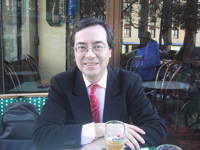
The
Gazette is edited
by Jean-Luc Rivera, who is well known in the UFO
community, but who also has an abiding interest in cryptozoology,
parapsychology, and all things fortean. As is often the case in such
ventures, the Gazette exists almost solely thanks
to Jean-Luc's
extensive knowledge, worldwide connections, and total devotion
to, and passion for, the subjects at hand, though Philippe Marlin, the
publisher of L'Oeil Du Sphinx, deserves recognition as well for his
unqualified support of the Gazette.

I
mention this as preamble to an event
that took place in Paris on October 14, 2006, the First French Fortean
Congress, held to celebrate the fifth anniversary of the publication of
La
Gazette Fortéenne. Jean-Luc's well
organized conference drew 50 or so people from
across France--including two from Switzerland and one from the
U.S. (me)--to its prestigious
location at L'Atelier Z, Centre Culturel Christiane Peugeot (yes, that
Peugeot). The day-long event featured a half dozen speakers who gave
their
presentations in a room adorned with bright and bold modern art.
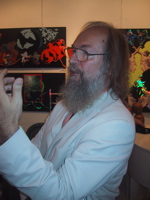
First
up was Francois de Sarre, a German
zoologist whose specialty is fish and the evolution of vertebrates. De
Sarre spoke about the place of unknown hominids within the highly
unorthodox theory of initial bipedalism, which turns the common view
that humans are the result of some rapid evolutionary changes from a
rather recent quadrupedal ape-like ancestor on its
head. Within this theoretical framework of initial bipedalism,
de Sarre views
the relic non-sapiens hominids as having descended
from homo sapiens!
De Sarre presented evidence that suggests that these unknown hominids
are representatives of collateral lineages that have survived
concurrently with Homo sapiens.
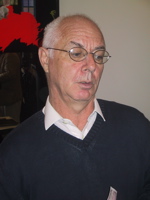 Next
was Bertrand Méheust,
a professor of philosophy, sociology and ethnology. Though
Méheust 's initial fortean interest focused on UFOs and
their relation to science fiction and folklore (a subject he plans to
revisit), for the past couple of decades his interest has centered on
the phenomenon of mesmerism. His major work on the subject is a book
entitled Un Voyant Prodigieux: Alexis Didier 1826-1886 (An
Extraordinary Seer). Méheust
gave a brief history of
parapsychology in France and noted that the subject is now for all
intents and purposes
banned from this country since the end of World War II, thanks to the
domination of the Marxist and communist ideas in the post-war French
intelligentsia; this is still true today, as the present objections to
parapsychology are the reflection of the criticism forged in the 1950s
and '60s. Next
was Bertrand Méheust,
a professor of philosophy, sociology and ethnology. Though
Méheust 's initial fortean interest focused on UFOs and
their relation to science fiction and folklore (a subject he plans to
revisit), for the past couple of decades his interest has centered on
the phenomenon of mesmerism. His major work on the subject is a book
entitled Un Voyant Prodigieux: Alexis Didier 1826-1886 (An
Extraordinary Seer). Méheust
gave a brief history of
parapsychology in France and noted that the subject is now for all
intents and purposes
banned from this country since the end of World War II, thanks to the
domination of the Marxist and communist ideas in the post-war French
intelligentsia; this is still true today, as the present objections to
parapsychology are the reflection of the criticism forged in the 1950s
and '60s.
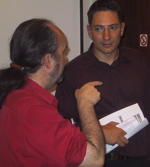 After a
lunch break, Fabrice Bonvin, the
Swiss author of Ovni: Les agents du changement (UFOs: Agents
of Change) outlined the many similarities between modern UFO
abduction accounts and fairy lore and incubus and succubus accounts
from the Middle Ages. After a
lunch break, Fabrice Bonvin, the
Swiss author of Ovni: Les agents du changement (UFOs: Agents
of Change) outlined the many similarities between modern UFO
abduction accounts and fairy lore and incubus and succubus accounts
from the Middle Ages.
At Jean-Luc's insistence, I then gave a brief overview of the state of
affairs for UFOlogy, cryptozoology, parapsychology and forteanism in
the U.S. I noted the lack of financial support for these endeavors, the
decline of the professional organizations in these areas, and the rise
of the internet as the primary source of information on these subjects
for the general public.
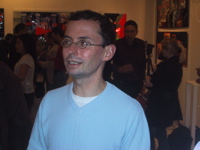 Unfortunately,
the next scheduled
speaker, Marie-Jeanne Koffmann, the 86-year-old doctor and expert on
the Almas, was back in her old
stomping grounds in the Caucasus Mountains of Asia, so
Benoit Grison, a biologist and sociologist, gave a cryptozoological
presentation in her stead. Grison spoke about the successes of the
field, including the recent discovery in Vietnam of the species of wild
steer the locals called linh duong. He argued for a
narrow definition
of cryptozoological discovery, one that involves not only an animal new
to
science that is known to locals, but that it must be
controversial as well. These he called the "Big Cases"--such as the
Bigfoot and Nessie accounts -- that define the field. Unfortunately,
the next scheduled
speaker, Marie-Jeanne Koffmann, the 86-year-old doctor and expert on
the Almas, was back in her old
stomping grounds in the Caucasus Mountains of Asia, so
Benoit Grison, a biologist and sociologist, gave a cryptozoological
presentation in her stead. Grison spoke about the successes of the
field, including the recent discovery in Vietnam of the species of wild
steer the locals called linh duong. He argued for a
narrow definition
of cryptozoological discovery, one that involves not only an animal new
to
science that is known to locals, but that it must be
controversial as well. These he called the "Big Cases"--such as the
Bigfoot and Nessie accounts -- that define the field.
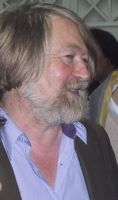
The
final speaker was Michel Meurger, the
French folklorist, whose work has covered alien abductions, lake
monsters, dragons and more. Appropriately enough for the occasion,
Meurger gave a
concise history of forteanism and summarized the current state of the
field. Overall, despite some disappointments, he views
the situation as one of a glass half full (rather than half empty, as I
did in my presentation) and even saw as encouraging the
commercialization of forteanism in Great Britain, as illustrated by the
newsstand magazine, Fortean Times. And what better
example of the continued success of forteanism, he noted, than the very
existence of this very first French fortean conference!
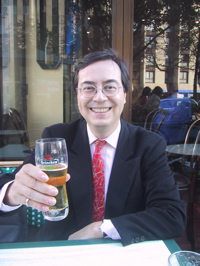
I
couldn't agree more.
Thank you, Jean-Luc Rivera, and cheers to a conference
(and journal) well done.
|
|



